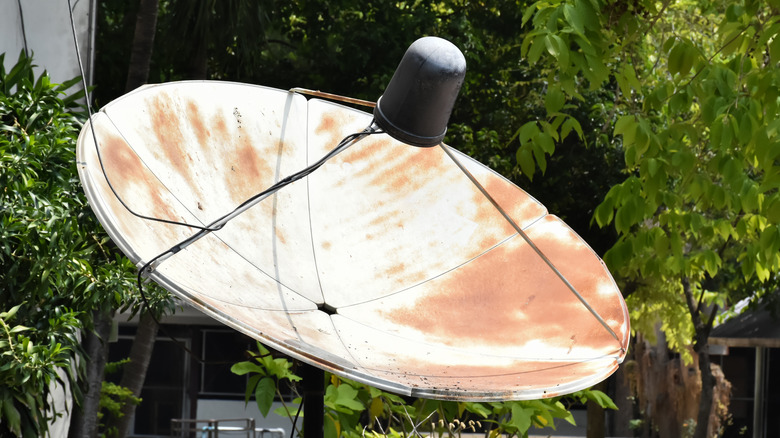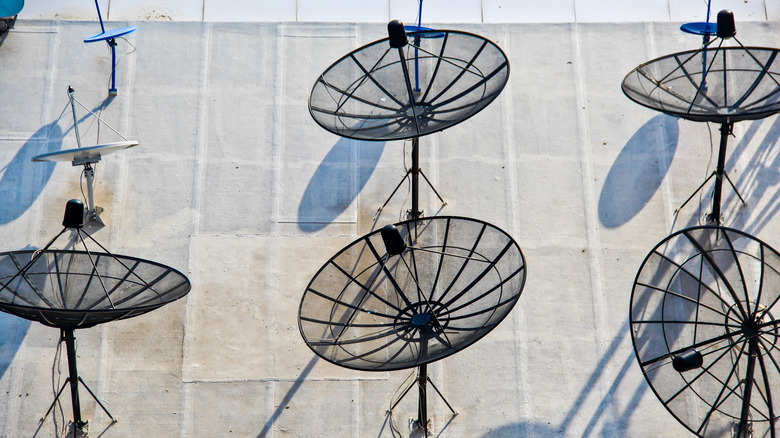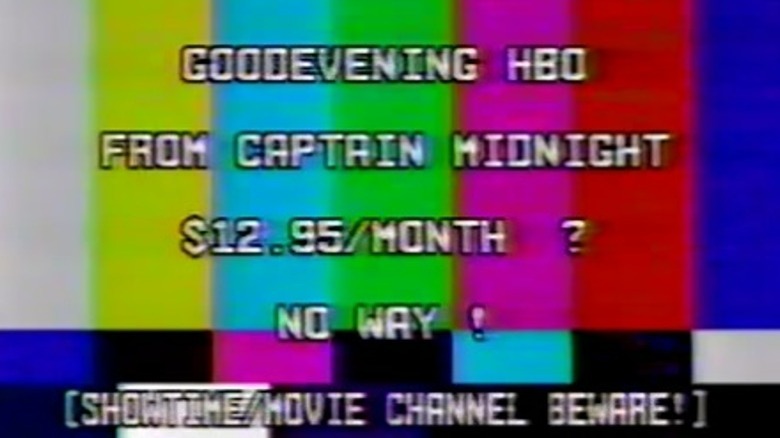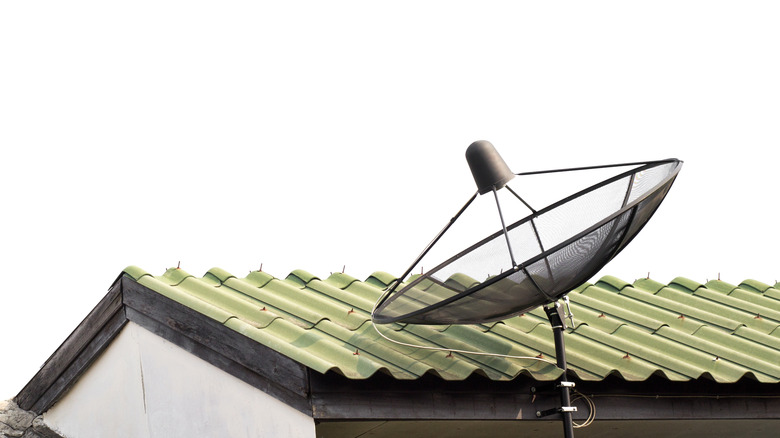Remember Those Giant Satellite Dishes That Were Everywhere? Here's What They Were For
Satellite television has become ubiquitous today. Cutting the cord on cable boxes offers a number of advantages to homeowners, and for sports fans, satellite is often the only way to go in order to receive the full breadth of content that an avid sports viewer demands. Fittingly enough, the first satellite television broadcast from HBO was the "Thrilla in Manila," in September of 1975. Satellite broadcasts then became a standard practice to support nationwide delivery of television programming by HBO and others.
Yet, satellite television was being deployed in other areas, and a BBC engineer in England successfully built the first personal receiver in 1975 as well. Steven Birkill discovered that a NASA satellite was being used to broadcast educational television to India's rural villages, and went about capturing these signals for himself. After months of tinkering with the device and playing with times and dish positioning, he finally caught the All India Radio crest on his screen.
This breakthrough led to an expansion of home satellite dishes and video access to homes tremendously. The gigantic receivers caught C-Band broadcast signals and truly led a revolution in television. Today, they are little more than relics of a bygone era of innovation and quasi-banditry.
The C-Band dish unlocked television access for home viewers
In 1979, the first commercially available C-Band dishes hit the market for a whopping $36,000. A few years later, their price tag had rapidly reduced, selling for around $1,500 in 1985. What users and builders had found was a gap in the broadcasting norms of the day.
Broadcasters like HBO sent signal to local cable distributors over a stable C-Band satellite signal so that television programming could be delivered throughout the country without interruption. However, these signals weren't shielded in any way. The technology and know-how to catch them simply didn't exist until Steven Birkill's homemade receiver took in Indian TV from his home in the U.K.
From that moment on, anyone with a C-Band dish could tune into the direct feed and watch television without paying for a subscription. Sales ballooned, especially in areas of the United States covered in mountainous terrain that made traditional television delivery a challenge. C-Band dishes were large and needed to be aimed more precisely than the generation of satellite dishes that would come later.
This is because the power level of the signals they were catching was much lower than today's satellite broadcasts. However, this allowed for a stable transmission that was far more adept at persisting through poor weather and other features that limit satellite TV.
Broadcasters quickly plugged the hole in their infrastructure
The prevalence of C-Band dishes was fueled by the fact that only other broadcasting outlets could initially collect these signals. The dish was a consumer innovation that made TV free, and exceedingly cool to interact with. However, HBO and others eventually got around to protecting their signals, forcing viewers to purchase equipment to decrypt the feed and ultimately, purchase the subscription costs that had successfully been shed with the help of a C-Band receiver previously. Legislation in 1984 allowed broadcasters to scramble their feed, creating a new tension between distributors and their viewers.
By 1986, over one million U.S. homes had a satellite dish installed, and scrambled signals soon followed. Broadcasters called dish owners "pirates," claiming that their primary motivation was access to free television. Yet, many in the community of satellite enthusiasts made it clear that they were willing to pay for these services.
Regardless of individual intentions, the rapid accumulation of satellite utilization and knowledge gave rise to the modern age of technologically advanced satellite TV services. There are also some now-famous shots fired in this broadcasting battle, including Captain Midnight's signal override of HBO in April 1986, and the November 1987 Max Headroom Incident that remains a mystery to this day.
[Featured image by John R. MacDougall via Wikimedia Commons | Cropped and scaled | Public Domain]
Nowadays, you can build massive Wi-Fi coverage with old C-Band tech
Diehard C-Band enthusiasts note that you can still reach up and pluck some channels out of the air with one of these satellite dishes. Like ham radio operators, the novelty of establishing a working television signal with one of these relics brings a meeting of ingenuity and vintage, technological charm together that's fun. However, one of the more relevant uses for these sizeable satellite dishes is the establishment of massive Wi-Fi networks.
With a C-Band dish, you can replace a few key signal reception components into a Wi-Fi antenna that can expand coverage from the typical few meters to many miles. It should be noted that the coverage area must be clear of obstructions like hills, buildings, or other structures. Yet, for rural residents, building a wide ranging wireless coverage area can be immensely beneficial.
For one thing, farm owners could use an old C-Band dish to create a coverage window extending to the far reaches of their property. This would open up the potential for a variety of beneficial connectivity additions around their farm land (for instance, sensors to monitor growth, security systems, or networked and automated feeding or watering solutions).
C-Band actually remains in use for certain contexts
Even after C-Band receivers became a dated consumer technology, enterprise distribution outlets still kept these tools on as a reliable means to distribute both live and scheduled programming. The high degree of reliability makes them a valuable tool for ensuring a potent signal, even when the weather turns rotten.
As well, David Butler wrote in 1996 for the Roanoke Times that "C-band remains the ultimate delivery vehicle for television programming," many years after consumers had effectively lost the fight for free-to-air content. In addition to its use as a tool for providing expanded wireless coverage, C-Band satellite dishes are also still used to catch hundreds of educational and informational channels that are broadcast without their signals scrambled.
C-SPAN, NASA, and international news broadcasts can still be caught with these dishes. C-Band dishes are a unique relic from a distance past surpassed by all that consumer technology had to offer after it. Still, these massive satellite dishes provide a few thrills and niche value for many folks around the world.




